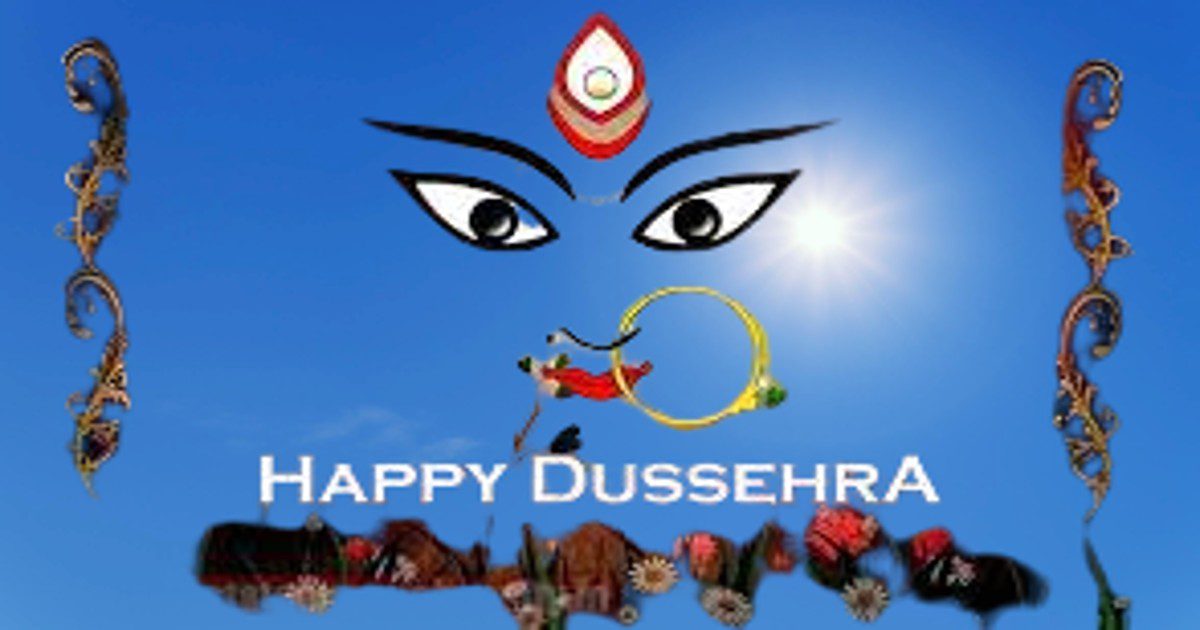Dussehra: Every year, the Durga Puja festival starts on the 6th day of Sharada Navratri. In 2023, Durga Puja will be celebrated from Friday, October 20, 2023, till Tuesday, October 24, 2023. Durga Puja 2023 will be celebrated in the month of October with Mahalaya on 14 October and Maha Panchami on 19 October, Maha Sashti on 20th October, Maha Saptami on 21st October, Maha Ashtami on 22nd October, Maha Navami on 23rd October and the 10th Day will be celebrated as Vijayadashami or Dussehra which falls this year on Tuesday, 24th October’23.
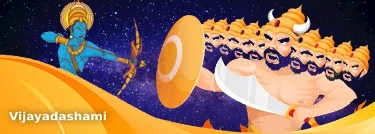
Dussehra 2023
Vijayadashami is celebrated as victory of Lord Rama over Demon Ravana and also triumph of Goddess Durga over the buffalo Demon Mahishasura. Vijayadashami is also known as Dussehra or Dasara. In Nepal Dasara is celebrated as Dashain.
Shami Puja, Aparajita Puja and Seema Avalanghan are some of the rituals which are followed on the day of Vijayadashami. According to Hindu division of the day, these rituals should be done during Aparahna time.
On this day, the Devi begins her journey back home. One of the most interesting parts of the day lies in the Sindoor khela. Here, married women offer baran (farewell) in the form of betel leaf, sweets and vermillion to the Devi. After this, the ladies apply sindoor in the parting of each other’s hair and smear the rest of it on each other’s faces.
As sindoor is a mark of a married woman, this ritual is believed to be a prayer to the Devi for the health and peace of their families as well as spouses. Dressed in laal-paar-saada-sarees (white saree with crimson border) and covered in red vermillion, the joy is evident from the faces of the women.
Vijaya dashami also known as Dussehra, Dasara or Dashain, is a major Hindu festival celebrated every year at the end of Navaratri. It is observed on the tenth day of the month of Ashvin, the seventh in the Hindu Luni-Solar Calendar. The festival which typically falls in the Gregorian calendar months of September and October.
In the northern, central and western states, it marks the end of Ramlila and commemorates god Rama’s victory over the demon king Ravana. Alternatively, it marks a reverence for one of the aspects of goddess Devi, such as Durga or Saraswati.
Followed by the Sindoor khela, Bisorjon(immersion) of the idol of the Devi is the concluding ceremony to the Durga puja. For some, it is an emotional moment to see Maa leaving. The idol of Maa Durga as well as the Nabapatrikaare immersed in the river surrounded by the huge crowds of devotees that have come to see them off.
The water (Shanti Jal) collected from the immersion spot is sprinkled on the devotees embracing the calm left behind by Maa. Teary-eyed, people return home with the Devi housed in their hearts.
Vijayadashami Significance
Vijayadashami is a compound of the two words vijaya (‘victory’) and dasami (‘tenth’), connoting the festival on the tenth day celebrating the victory of good over evil.
The celebration of this festival is founded in the epic Ramayana. It is the day Rama defeats the demon king Ravana, after kidnapping Rama’s wife, Sita. Ravana kidnaps Sita and takes her to his kingdom in Lanka (present day Sri Lanka). Rama asks Ravana to release her, but Ravana refuses; the situation escalates and leads to war. Prior to this, Ravana performed severe penance for ten thousand years and received a boon from the creator-god Brahma that he could henceforth not be killed by gods, demons, or spirits.
However, Rama (a human and incarnate of Lord Vishnu) defeats and kills him, thus circumventing the boon given by Lord Brahma. A battle takes place between Rama and Ravana in which Rama kills Ravana and ends his evil rule. Finally, dharma was established on the Earth because of Rama’s victory over Ravana. The festival commemorates the victory of Good over Evil.
In the Mahabharata, Vijayadashami also marks the day that the Pandava warrior Arjuna defeats the Kauravas. The epic tells the story of the Pandava brothers who are known to have spent their thirteenth year of exile under concealed identity in Matsya, the kingdom of Virata. Before going to Virata, they are known to have hung their celestial weapons in a Shami tree for safekeeping for a year. It was during this time that Kauravas decided to attack the kingdom in which Arjuna retrieved the weapons from the Shami tree and defeated the entire Kaurava army.
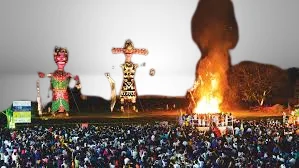
Vijayadashami is observed for different reasons and celebrated differently in various parts of the Indian subcontinent. In the southern, eastern, northeastern, and some northern states of India, Vijayadashami marks the end of Durga Puja, remembering goddess Durga’s victory against the buffalo demon Mahishasura to restore and protect dharma.
Navaratri is a nine-day festival celebrated in India to honour the Mother Goddess in all her avatars (forms). Navratri is celebrated twice every year, once in the month Chaitra (March) and then in the month of Ashwin (September-October). The latter ( Durga Puja ) consists of the main rituals of placing the idol or image of the Goddess in homes and temples and immersed in water after the nine days of Navaratri. Navratri is a Sanskrit word which means nine nights. On these nine nights and ten days, nine different forms of Goddess Durga are worshipped.
According to some Hindu texts such as the Shakta and Vaishnava Puranas, Navaratri theoretically falls twice or four times in a year. Of these, the Sharada Navaratri ( During Durga Puja ) near the September equinox (the autumn equinox in September–October) is the most celebrated and the Vasanta Navaratri near the March equinox (the spring equinox in March–April) is the next most significant to the culture of the Indian subcontinent. In all cases, Navaratri falls in the bright half (waxing phase) of the Hindu lunisolar months. The celebrations vary by region, leaving much to the creativity and preferences of the Hindu.
Chaitra Navaratri, also called Vasantha Navaratri, is the second most celebrated Navaratri, named after vasanta which means spring. It is observed during the lunar month of Chaitra (March–April). The festival is devoted to goddess Durga, whose nine forms are worshipped on nine days. The last day is also Rama Navami, the birthday of Rama. For this reason, it is also called Rama Navaratri by some people.
Sharada Navaratri is the most celebrated of the four Navaratri, named after Sharada which means autumn. It commences on the first day (pratipada) of the bright fortnight of the lunar month of Ashvini. The festival is celebrated for nine nights once every year during this month, which typically falls in the Gregorian months of September and October.
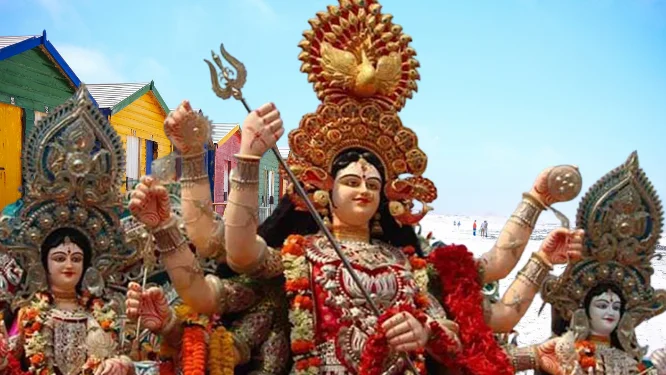
The festivities extend beyond goddess Durga and various other goddesses such as Saraswati and Lakshmi. Deities such as Ganesha, Kartikeya, Shiva, and Parvati are regionally revered. For example, a notable pan-Hindu tradition during Navaratri is the adoration of Saraswati, the Hindu goddess of knowledge, learning, music, and arts, through Ayudha Puja. On this day, which typically falls on the ninth day of Navaratri, peace and knowledge is celebrated.
Warriors thank, decorate, and worship their weapons, offering prayers to Saraswati. Musicians upkeep, play, and pray their musical instruments. Farmers, carpenters, smiths, pottery makers, shopkeepers, and all sorts of tradespeople similarly decorate and worship their equipment, machinery, and tools of trade. Students visit their teachers, express respect, and seek their blessings. This tradition is particularly strong in South India, but is observed elsewhere too.
| Sharada Navratri 2023: Dates and Schedule | ||
| Important Occasion | Date | Day |
| Pratipada, Day 1 | 15-Oct-23 | Sunday |
| Dwitiya, Day 2 | 16-Oct-23 | Monday |
| Tritiya, Day 3 | 17-Oct-23 | Tuesday |
| Chaturthi, Day 4 | 18-Oct-23 | Wednesday |
| Panchami, Day 5 | 19-Oct-23 | Thursday |
| Shashthi, Day 6 | 20-Oct-23 | Friday |
| Saptami, Day 7 | 21-Oct-23 | Saturday |
| Ashtami, Day 8 | 22-Oct-23 | Sunday |
| Navami, Day 9 | 23-Oct-23 | Monday |
| Dashami (Dussehra) | 24-Oct-23 | Tuesday |
Navratri is one of the festivals celebrated across the length and breadth of India, though the celebrations in one part of the country are quite different than the other. With various customs and traditions, each region of India has its unique way of celebrating the Navaratri by honouring the multiple forms of Mother Goddess with their rituals and ceremonies.
In Gujarat, Navaratri is a grand community event where apart from the ritual, people gather in large number at community grounds to perform the traditional dances of Dandiya Raas and Garba Raas along while singing devotional songs. People dress up in their traditional costumes and spend the evening dancing to the beats of popular traditional Gujarati songs. They also observe Jagran singing bhajans and praising the Goddess all night long.
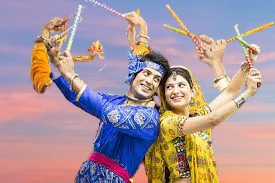
In Maharashtra, here the first and the last day of Navaratri is especially important. The first day is dedicated to Goddess Durga while the tenth day known as Vijayadashmi is dedicated to Saraswati – the Goddess of Knowledge. This day is considered auspicious to start anything new. Students keep their books and Businessmen keep their account books near the idol to seek blessings on their ventures. In Andhra Telangana, Navratri collides with Bathukamma which is also celebrated for nine days with exotic flowers and decorations.
However, some parts of Maharashtra especially Mumbai celebrates Navaratri like in Gujarat by organising events for Garba Raas and Dandiya Raas but with a twist to it. Apart from the traditional dances, Mumbai has also introduced its version of these dances that have become highly popular as Disco Dandiya where traditional songs are mixed with popular Bollywood songs. Cities like Ahmedabad, Surat, Vadodara also similarly celebrate Navratri.
In Bengal and the places around it, the last four days of Navaratri are celebrated as Durga Puja in honour of Goddess Durga. Huge idols of the Goddess are brought home or to community pandals (tents) to be worshipped for all the four days with different pujas for each day. On the last day, the idol is taken out in a procession to be immersed in water.
Dussehra in Odisha
Dussehra is said to be one of the most important festival in the Oriya calendar. It is the last day of the ten days of Durga Puja and as Cuttack is the cultural capital of the state, this festival is celebrated in grandest way possible. Life is said to be stand-still in the city as the crowds pour over the Puja Mandaps to enjoy the festivities.
In the Eastern region of the country after Kolkata, Cuttack is the only point of attraction for the Durga Puja. Kolkata is known across the globe for its sumptuous way of celebrating the Durga Puja with the incredible decoration and the stunning enlightenment. But, Cuttack is also known for its Durga Puja all over because of the lavishness in the techniques that are reflected in the gold and silver work especially for the idols of Goddess Durga.
As Cuttack is also known for the filigree work on gold and silver also has a major part to play in the Durga Puja. The silver tableaux also known as the ‘Chandi Medha’ in the pandals display a stunning sensation. These tableaux are especially designed by the artisans of Cuttack and intakes a lot of time in working on them.
As per the history, in the year 300 B.C. a King named Suratha who belonged to the Chedi Dynasty which used to rule the state at that time, started the rituals of Durga Puja in the state of Kalinga which is now known as Odisha. There are several terms being used for the Durga Puja in the Puranas and the Shastraas. It is termed as Mahaparbana in Devi Mahatmya and in Devi Purana and Kalika Purana it has being named Vijaya Dashami.
While the rulings of the Gnaga dynasty in the state of Kalinga, the idol worship of Goddess Durga started which is being followed till now. The idol of Goddess Durga made of clay was started in 11th century by the King Chodaganga Dev of Ganga Dynasty.
The history behind the modern day celebration of Durga puja in the city of Cuttack is centuries older. It is believed that in 16th century A.D during the rulings of then Gajapati, Pratap Rudra Dev, Shree Chaitanya Dev Mahaprabhu visited Cuttack. During that time he started the Durga Puja at the Balu Bazar near the Ganesh Ghat on the river bank of Kathoji at Cuttack. Hence the ritual are being performed since then and now every year there used to be more than 200 Puja pandals are being set up and Goddess Durga is worshiped.
The local artisans showcase their craftsmanship on the Puja Pandals in the form of Chandi Medha (Silver Tableaux). Both the Pandals and the Jewelry adorned by the idol is made of Silver Filigree.
The idol of the Goddess adorns a silver crown with peacocks, fish and flowers being the most common patterns. The idol also adorns a very long and thick silver filigree necklace, bajuband (armlet), kamarbandh (waist belt) and bangles. The tableaux in the pandals usually have patterns of peacock, Shankh (conch) and flowers.
The silver filigree craftsmanship is very intricate and It takes about 20 skilled artisans working 8 hours a day for 2 years to make a silver filigree pandal.
It takes 300-400 kgs of silver to make a pandal backdrop (tableau). The idol adorns jewellery of about 50 kgs, with the crown itself weighing 20 kgs.
Local Puja Committees of each locality are responsible for organizing the celebrations in their locality. The more a Puja Committee has access to funds, the more gold and silver is used in the pandals. There is a healthy competition between Committees to make the pandals more attractive.
There are about 160 Puja Committees in Cuttack, with about 22 Committees having Silver tableaux in Cuttack, and the number increases every year. The Durga Puja of Cuttack is notable for its usage of silver and gold tarakasi (filigree) work on the crown of the idols and also on the pandals. The city Cuttack attracts many tourists during this period of the year.
